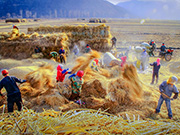

Tents of expedition teams are seen at the base camp of the northern face of Mount Qomolangma in southwest China's Tibet Autonomous Region, April 25, 2019. Every year, for a few weeks, hundreds of climbers and supporting personnel come to the base camp of the northern face of Mount Qomolangma, trying to reach the summit of the tallest and most famous mountain in the world. Before starting climbing, they need to hike several times between elevations from 5,000 meters to 7,000 meters, giving their bodies some time to adapt. When this process is over, it's all up to the weather. The base camp is a popular place to wait for the window. Among the six camps on the northern face, the base camp at an altitude of 5,200 meters is the furthest cars can reach and therefor the most equipped. Besides food and accommodation, climbers can also enjoy tea and massage. They can also play football on perhaps the highest field. There's even a simple gym in the camp. Environmental protection is a priority here. Garbage sacks are given to each climbing team. Special containers are put in every camp to collect trash and sewage. The collected trash must be treated 100 kilometers away, and the only road is a zigzagging track. It is not trucks, but yaks that are generally used to make the journey. Actually yaks are vital on the mountain. Beyond the base camp, yak is the only reliable transport. (Xinhua/Sun Fei)
 |  |

 Award-winning photos show poverty reduction achievements in NE China's Jilin province
Award-winning photos show poverty reduction achievements in NE China's Jilin province People dance to greet advent of New Year in Ameiqituo Town, Guizhou
People dance to greet advent of New Year in Ameiqituo Town, Guizhou Fire brigade in Shanghai holds group wedding
Fire brigade in Shanghai holds group wedding Tourists enjoy ice sculptures in Datan Town, north China
Tourists enjoy ice sculptures in Datan Town, north China Sunset scenery of Dayan Pagoda in Xi'an
Sunset scenery of Dayan Pagoda in Xi'an Tourists have fun at scenic spot in Nanlong Town, NW China
Tourists have fun at scenic spot in Nanlong Town, NW China Harbin attracts tourists by making best use of ice in winter
Harbin attracts tourists by making best use of ice in winter In pics: FIS Alpine Ski Women's World Cup Slalom
In pics: FIS Alpine Ski Women's World Cup Slalom Black-necked cranes rest at reservoir in Lhunzhub County, Lhasa
Black-necked cranes rest at reservoir in Lhunzhub County, Lhasa China's FAST telescope will be available to foreign scientists in April
China's FAST telescope will be available to foreign scientists in April